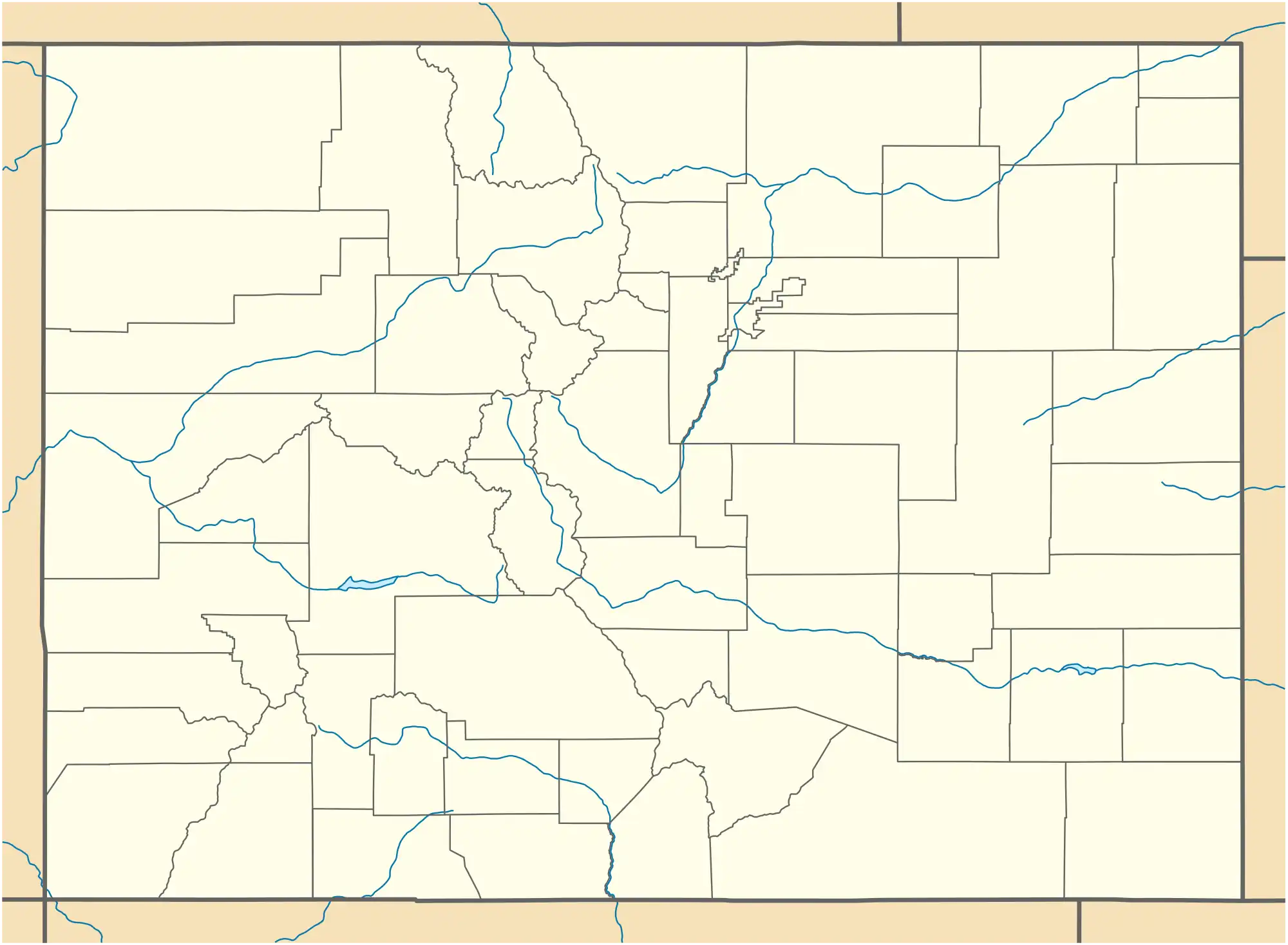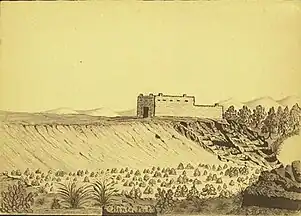Fort Lyon | |
 One of the Fort's main buildings in 2013. | |
  | |
| Location | Bent County, Colorado |
|---|---|
| Nearest city | Las Animas |
| Coordinates | 38°04′27″N 103°07′57″W / 38.07417°N 103.13250°W |
| Built | The second Fort Lyon was built in 1867 |
| Architect | U.S. Army; et al. |
| Architectural style | Colonial Revival, Bungalow/Craftsman |
| NRHP reference No. | 04000388[1] |
| CSRHP No. | 5BN.117 |
| Added to NRHP | 5 May 2004 |
Fort Lyon was composed of two 19th-century military fort complexes in southeastern Colorado. The initial fort, also called Fort Wise, operated from 1860 to 1867. After a flood in 1866, a new fort was built near Las Animas, Colorado, which operated as a military post until 1897.
It has been used as a United States Army fort, a sanatorium, a neuropsychiatry facility, and a minimum security prison. The state closed the prison in 2011, and in early 2013 proposed to use the site as a rehabilitation center for homeless people. Then in late 2013 it became a rehabilitative transitional housing facility for homeless people with some form of substance abuse problem. This is run by the Colorado Coalition for the Homeless and has been a developing program to the present day.
The fort is listed on the National Register of Historic Places. Part of the site, the Fort Lyon National Cemetery, which began burials in 1907, remains open.
History
Fort Lyon (1860–1867)

In July 1860, the Army rented Bent's New Fort and used it for storage of annuity goods for the Cheyenne and Arapaho.[2][lower-alpha 1] Annuity goods were provided by treaties in exchange for reduced access to ancestral land, such as hunting grounds.[4] Barracks were built around the fort[5] and additional defensive features were added, like diamond-shaped gun emplacements on newly-erected earthenworks that surrounded the fort.[6]
At the same time (1860) the Army constructed a new fort about one-half mile west of Bent's New Fort adjacent to the Arkansas river, naming it Fort Wise for Henry A. Wise, the governor of Virginia. After the start of the American Civil War and Virginia's secession from the Union, it was renamed Fort Lyon in 1862 for Brigadier General Nathaniel Lyon, who had been the first Union general killed in the Civil War.[5]
In 1861, the Treaty of Fort Wise was signed at the fort. The goal, which was short-lived, was to ensure peace between settlers and the Cheyenne and Arapaho people.[7] Old Fort Lyon was the staging post used by Colonel John Chivington in 1864 as he led an attack on friendly Cheyenne and Arapaho camps that became known as the Sand Creek massacre. To prevent word spreading of the impending attack, Chivington had guards posted at the fort to prevent people and mail from reaching Sand Creek.[7][8]
In 1866 after flooding on the Arkansas River, the U.S. Army relocated Ft. Lyon 20 miles upstream to a site near Las Animas. The new facility was completed in 1867 and the old site, including Bent's New Fort, was abandoned.[5][9]
Fort Lyon (1867–1897)
In 1867, a new fort called Fort Lyon was built near the present-day town of Las Animas, Colorado. The U.S. Army used Fort Lyon until 1897, when they abandoned it after the end of the Indian Wars.[7]
Medical, prison, and psychiatric facilities
In 1906, the U.S. Navy opened a sanatorium there to treat sailors and Marines with tuberculosis. The dry climate and rest by isolation at the fort were thought to be beneficial by contemporary treatment methods. On 22 June 1922, the Veteran's Bureau assumed operations. In 1930, administration of the hospital was transferred to the newly created Veterans Administration. Within three years, the VA designated Fort Lyon a neuropsychiatry facility. In 2001 the hospital was closed and the facility was turned over to the state of Colorado for conversion to a minimum security prison. The prison was closed in 2011.
In September 2013, Governor John Hickenlooper announced that Fort Lyon had reopened as an isolated transitional housing facility for homeless people with substance abuse issues[10] operated by the Colorado Coalition for the Homeless.[11][12] As of November 2018, there were over 200 clients there.[13]
See also
Notes
References
- ↑ "National Register Information System". National Register of Historic Places. National Park Service. 15 April 2008.
- ↑ William Y. Chalfant (1 October 2002). Cheyennes and Horse Soldiers: The 1857 Expedition and the Battle of Solomon's Fork. University of Oklahoma Press. pp. 242–243. ISBN 978-0-8061-3500-7.
- ↑ David Sievert Lavender (1954). Bent's Fort. U of Nebraska Press. p. 447. ISBN 0-8032-5753-8.
- ↑ "Indian Annuities". Colorado Encyclopedia. 27 April 2017. Retrieved 15 June 2018.
- 1 2 3 Roland G. Robertson (1 September 2012). Competitive Struggle: America's Western Fur Trading Posts, 1764-1865. University of Nebraska Press. p. 70. ISBN 978-0-87004-571-4.
- ↑ Bent's Old Fort National Historic Site General Management Plan (GMP), Development Concept Plan, Otero County: Environmental Impact Statement. 1994. pp. 102–103.
- 1 2 3 Spencer C. Tucker; Paul G. Pierpaoli Jr. (24 March 2015). American Civil War: A State-by-State Encyclopedia [2 volumes]: A State-by-State Encyclopedia. ABC-CLIO. p. 79. ISBN 978-1-59884-529-7.
- ↑ Douglas C. Comer (23 December 1996). Ritual Ground: Bent's Old Fort, World Formation, and the Annexation of the Southwest. University of California Press. p. 238. ISBN 978-0-520-91870-2.
- ↑ William B. Butler (2012). The Fur Trade in Colorado. Western Reflections Publishing Company. pp. 117–118. ISBN 978-1-937851-02-6.
- ↑ Gov. Hickenlooper applauds reopening of Fort Lyon as innovative homeless recovery opportunity Archived 10 September 2013 at the Wayback Machine. Press release, 3 September 2013.
- ↑ Lydia DePillis (8 August 2014). "Why Denver is trucking its homeless to the middle of nowhere". The Washington Post. Retrieved 18 January 2015.
Early indicators of success aside, the reason the program at Fort Lyon exists is because of failure. For about 80 years, the former military base had been a neuropsychiatric facility for traumatized veterans, but closed in 2001 after proving too expensive to operate. After that, the state Department of Corrections turned it into a minimum security prison, but that folded in 2011 after transportation costs got too high, since medical specialists are so far away. Finally, Bent County partnered with the Colorado Coalition for the Homeless to create a kind of treatment that would remove people from everything that had enabled their addiction in the first place, and stay there for an extended period of time...
- ↑ Tom McGhee (20 August 2014). "Controversial Fort Lyon homeless facility sends alums into world". The Denver Post. Retrieved 18 January 2015.
For the 202 residents, who may stay from 90 days up to two years, the graduations are an encouraging sign that the shelter's remote location and array of services will, over time, reduce homelessness in the metro area, said Joseph Parvensky, president of the Colorado Coalition for the Homeless, which administers the program.
- ↑ Ford, Sarah (1 November 2018). "Five Years At Fort Lyon". Denver Voice. Retrieved 12 August 2020.
Further reading
- Roe, Frances Marie Antoinette Mack (1909). Army letters from an officer's wife, 1871–1888. D. Appleton.Available online, Washington State Library's Classics in Washington History collection. In 1871, Frances M.A. Roe accompanied her husband, Lieutenant Colonel Fayette Washington Roe (1850–1916), to his assignment at Fort Lyon, Colorado Territory. In this collection of letters, she describes their experiences while stationed at the fort.
External links
- Fort Lyon National Cemetery
- State of Colorado Dept. of Corrections: Fort Lyon Archived 2 October 2006 at the Wayback Machine